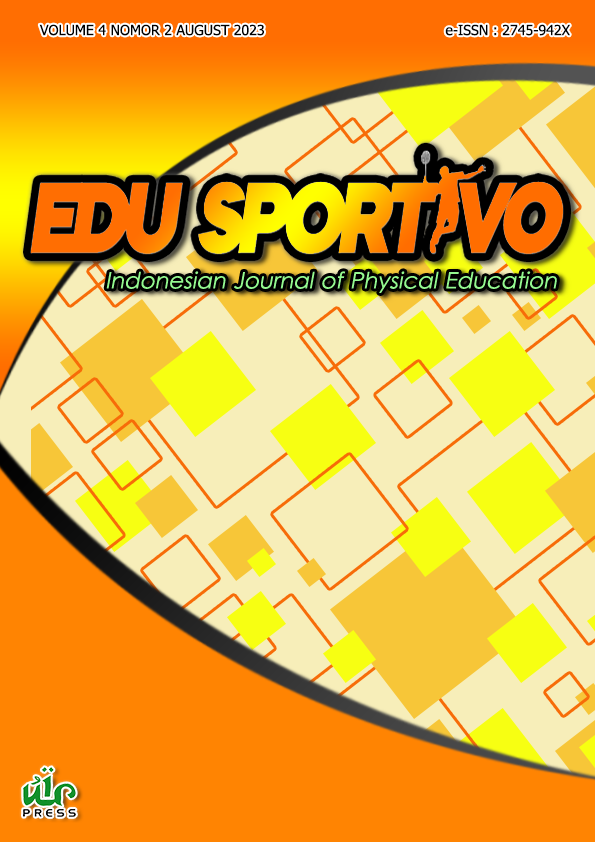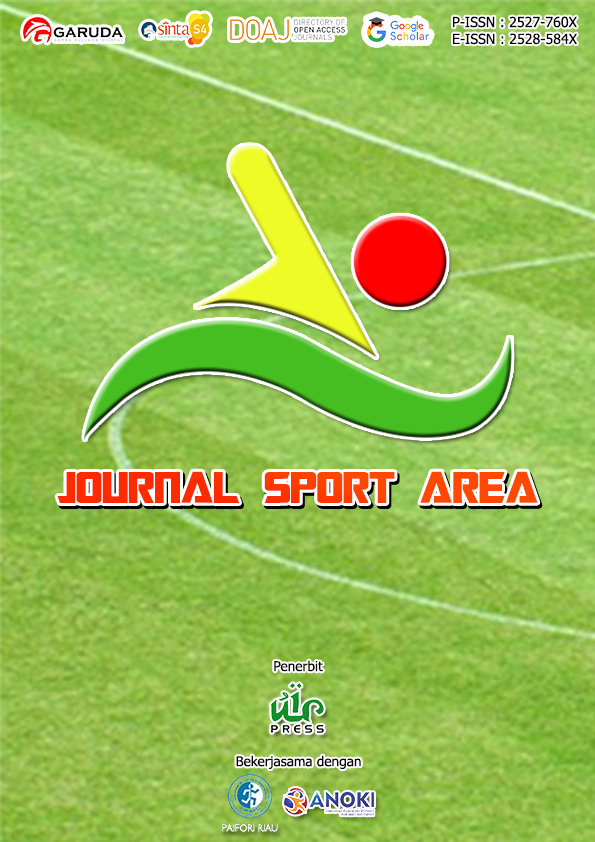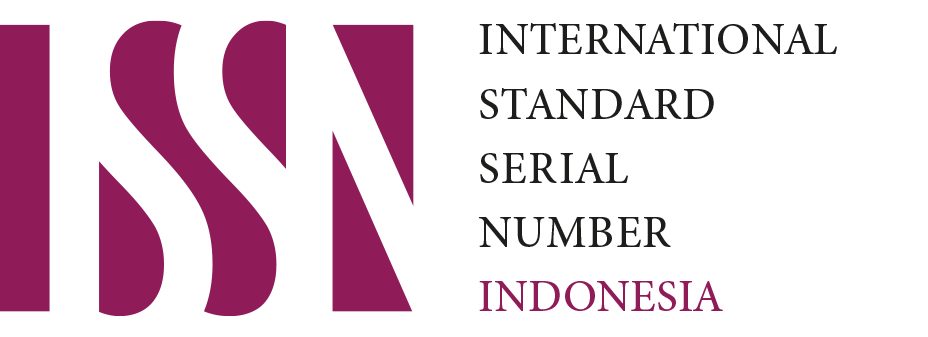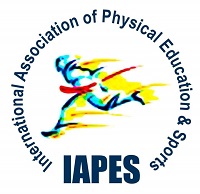Comparing the effects of hybrid and online learning on physical activity and body mass index: A quasi-experimental investigation
Keywords:
BMI, physical activity, hybrid learning, online learningAbstract
Changes in learning methods at school can affect students' learning habits and activity patterns. This study aims to investigate the effect of hybrid learning compared to online learning on fitness level and body composition, specifically focusing on body mass index (BMI). The research method used was a quasi-experiment with a pretest-posttest control group design approach. The number of research subjects was 128 students with an average age of 10.35 ± 0.67 years, a body weight of 42.05 ± 8.97 kg, and a height of 142.84 ± 7.94 cm. The results showed that the post-test BMI score in the hybrid learning group decreased significantly, p < 0.05, by 19.69 kg/m2, and there was an increase in physical activity of 2.94 METs. Whereas in the online learning group, there was no significant difference in BMI or physical activity variables. The results of this study are expected to be a reference for teachers in schools and other educators to apply the hybrid method compared to online learning so that students' physical activity patterns can be maintained and continuously improved, which has an impact on body composition. The findings can also help in reducing physical activity patterns in big cities on the island of Sumatera and can be a discussion for researchers to create or modify more effective and efficient learning methods.
Downloads
References
Adamakis, M. (2021). Physical activity, sleep and weight management in the covid-19 era: A case report. Journal of Physical Education and Sport, 21(1), 60–65. https://doi.org/10.7752/jpes.2021.01008 DOI: https://doi.org/10.7752/jpes.2021.01008
Besser, A., Flett, G. L., & Zeigler-Hill, V. (2022). Adaptability to a sudden transition to online learning during the COVID-19 pandemic: Understanding the challenges for students. Scholarship of Teaching and Learning in Psychology, 8(2), 85–105. https://doi.org/10.1037/stl0000198 DOI: https://doi.org/10.1037/stl0000198
Camargo, C. P., Tempski, P. Z., Busnardo, F. F., de Arruda Martins, M., & Gemperli, R. (2020). Online learning and COVID-19: a meta-synthesis analysis. Clinics, 75, 1–4. https://doi.org/10.6061/clinics/2020/e2286 DOI: https://doi.org/10.6061/clinics/2020/e2286
Chung, E., Subramaniam, G., & Christ Dass, L. (2020). Online Learning Readiness Among University Students in Malaysia Amidst Covid-19. Asian Journal of University Education, 16(2), 45-58. https://doi.org/10.24191/ajue.v16i2.10294 DOI: https://doi.org/10.24191/ajue.v16i2.10294
Ciotti, M., Ciccozzi, M., Terrinoni, A., Jiang, W. C., Wang, C. Bin, & Bernardini, S. (2020). The COVID-19 pandemic. Critical Reviews in Clinical Laboratory Sciences, 57(6), 365–388. https://doi.org/10.1080/10408363.2020.1783198 DOI: https://doi.org/10.1080/10408363.2020.1783198
de Boer, A., Pijl, S. J., & Minnaert, A. (2012). Students’ Attitudes towards Peers with Disabilities: A review of the literature. International Journal of Disability, Development and Education, 59(4), 379–392. https://doi.org/10.1080/1034912X.2012.723944 DOI: https://doi.org/10.1080/1034912X.2012.723944
Fan, Q., Wang, H., Kong, W., Zhang, W., Li, Z., & Wang, Y. (2021). Online Learning-Related Visual Function Impairment During and After the COVID-19 Pandemic. Frontiers in Public Health, 9, 1–9. https://doi.org/10.3389/fpubh.2021.645971 DOI: https://doi.org/10.3389/fpubh.2021.645971
Grunt, E. V., Belyaeva, E. A., & Sabina, L. (2020). Distance education during the pandemic: new challenges to Russian higher education. Perspectives of Science and Education, 47(5), 45–58. https://doi.org/10.32744/pse.2020.5.3 DOI: https://doi.org/10.32744/pse.2020.5.3
Guan, H., Okely, A. D., Aguilar-Farias, N., del Pozo Cruz, B., Draper, C. E., El Hamdouchi, A., Florindo, A. A., Jáuregui, A., Katzmarzyk, P. T., Kontsevaya, A., Löf, M., Park, W., Reilly, J. J., Sharma, D., Tremblay, M. S., & Veldman, S. L. C. (2020). Promoting healthy movement behaviours among children during the COVID-19 pandemic. The Lancet Child and Adolescent Health, 4(6), 416–418. https://doi.org/10.1016/S2352-4642(20)30131-0 DOI: https://doi.org/10.1016/S2352-4642(20)30131-0
Gultom, J. R., Sundara, D., & Fatwara, M. D. (2022). Pembelajaran Hybrid Learning Model Sebagai Strategi Optimalisasi Ssistem Pembelajaran di Era Pandemi Covid-19 Pada Perguruan Tinggi di Jakarta. Mediastima, 28(1), 11–22. https://doi.org/10.55122/mediastima.v28i1.385 DOI: https://doi.org/10.55122/mediastima.v28i1.385
Hennessy, M., Bleakley, A., Ellithorpe, M. E., Maloney, E., Jordan, A. B., & Stevens, R. (2023). Reducing Unhealthy Normative Behavior: The Case of Sports and Energy Drinks. Health Education & Behavior, 50(3), 394–405. https://doi.org/10.1177/10901981211055468 DOI: https://doi.org/10.1177/10901981211055468
Hyunshik, K., Jiameng, M., Sunkyoung, L., & Ying, G. (2021). Change in Japanese children’s 24-hour movement guidelines and mental health during the COVID-19 pandemic. Scientific Reports, 11(1), 1–10. https://doi.org/10.1038/s41598-021-01803-4 DOI: https://doi.org/10.1038/s41598-021-01803-4
Johnson, A. M., Knell, G., Walker, T. J., & Kroshus, E. (2023). Differences in American adolescent sport participation during the COVID-19 pandemic by learning mode: A national survey. Preventive Medicine Reports, 32, 102151. https://doi.org/10.1016/j.pmedr.2023.102151 DOI: https://doi.org/10.1016/j.pmedr.2023.102151
Kapasia, N., Paul, P., Roy, A., Saha, J., Zaveri, A., Mallick, R., Barman, B., Das, P., & Chouhan, P. (2020). Impact of lockdown on learning status of undergraduate and postgraduate students during COVID-19 pandemic in West Bengal, India. Children and Youth Services Review, 116, 105194. https://doi.org/10.1016/j.childyouth.2020.105194 DOI: https://doi.org/10.1016/j.childyouth.2020.105194
Kenney, W. L., Wilmore, J. H., & Costil, D. L. (2015). Physiology of Sport and Exercise. Sixth Edition. In Human Kinetics.
Lestari, S, S., Latifah, S., Engkizar, E., Damri, D., Asril, Z., & Yaumas, N. E. (2021). Hybrid learning on problem-solving abiities in physics learning: A literature review. Journal of Physics: Conference Series, 1796(1), 012021. https://doi.org/10.1088/1742-6596/1796/1/012021 DOI: https://doi.org/10.1088/1742-6596/1796/1/012021
Mocanu, G. D., Murariu, G., Iordan, D. A., Sandu, I., & Munteanu, M. O. A. (2021). The Perception of the Online Teaching Process during the COVID-19 Pandemic for the Students of the Physical Education and Sports Domain. Applied Sciences, 11(12), 1–22. https://doi.org/10.3390/app11125558 DOI: https://doi.org/10.3390/app11125558
Mukhtar, K., Javed, K., Arooj, M., & Sethi, A. (2020). Advantages, Limitations and Recommendations for online learning during COVID-19 pandemic era. Pakistan Journal of Medical Sciences, 36(4), 27–31. https://doi.org/10.12669/pjms.36.COVID19-S4.2785 DOI: https://doi.org/10.12669/pjms.36.COVID19-S4.2785
Nopembri, S., Mulyawan, R., Fauziah, P. Y., Kusumawardani, E., Susilowati, I. H., Fauzi, L., Cahyati, W. H., Rahayu, T., Chua, T. B. K., & Chia, M. Y. H. (2023). Time to Play in Javanese Preschool Children—An Examination of Screen Time and Playtime before and during the COVID-19 Pandemic. International Journal of Environmental Research and Public Health, 20(3), 1–12. https://doi.org/10.3390/ijerph20031659 DOI: https://doi.org/10.3390/ijerph20031659
Paudel, P. (2020). Online Education: Benefits, Challenges and Strategies During and After COVID-19 in Higher Education. International Journal on Studies in Education, 3(2), 70–85. https://doi.org/10.46328/ijonse.32 DOI: https://doi.org/10.46328/ijonse.32
Pavlovic, A., DeFina, L. F., Natale, B. L., Thiele, S. E., Walker, T. J., Craig, D. W., Vint, G. R., Leonard, D., Haskell, W. L., & Kohl, H. W. (2021). Keeping children healthy during and after COVID-19 pandemic: meeting youth physical activity needs. BMC Public Health, 21(1), 1–8. https://doi.org/10.1186/s12889-021-10545-x DOI: https://doi.org/10.1186/s12889-021-10545-x
Radu, M.-C., Schnakovszky, C., Herghelegiu, E., Ciubotariu, V.-A., & Cristea, I. (2020). The Impact of the COVID-19 Pandemic on the Quality of Educational Process: A Student Survey. International Journal of Environmental Research and Public Health, 17(21), 1–15. https://doi.org/10.3390/ijerph17217770 DOI: https://doi.org/10.3390/ijerph17217770
Rocamora, I., Casey, A., González-Víllora, S., & Arias-Palencia, N. M. (2023). A Comparison of Motivation and Physical Activity Levels Between a Sport Education Season and a Hybrid Sport Education and Cooperative Learning Season. Journal of Teaching in Physical Education, 42(2), 350–360. https://doi.org/10.1123/jtpe.2021-0077 DOI: https://doi.org/10.1123/jtpe.2021-0077
Rusli, R., Rahman, A., & Abdullah, H. (2020). Student perception data on online learning using heutagogy approach in the Faculty of Mathematics and Natural Sciences of Universitas Negeri Makassar, Indonesia. Data in Brief, 29, 1–6. https://doi.org/10.1016/j.dib.2020.105152 DOI: https://doi.org/10.1016/j.dib.2020.105152
Timpka, T. (2020). Sports Health During the SARS-Cov-2 Pandemic. Sports Medicine, 50(8), 1413–1416. https://doi.org/10.1007/s40279-020-01288-7 DOI: https://doi.org/10.1007/s40279-020-01288-7
Xiao, J., Sun‐Lin, H., Lin, T., Li, M., Pan, Z., & Cheng, H. (2020). What makes learners a good fit for hybrid learning? Learning competences as predictors of experience and satisfaction in hybrid learning space. British Journal of Educational Technology, 51(4), 1203–1219. https://doi.org/10.1111/bjet.12949 DOI: https://doi.org/10.1111/bjet.12949
Yudaparmita, G. N. A., Kanca, I. N., Sudiana, I. K., & Dharmadi, M. A. (2023). Hybrid Learning on Pencak Silat Sport in Higher Education: Students’ Perception and Issues. Journal of Higher Education Theory and Practice, 23(1), 9–22. https://doi.org/10.33423/jhetp.v23i1.5781 DOI: https://doi.org/10.33423/jhetp.v23i1.5781
Yulianti, M., Apriani, L., & Makorohim, M. F. (2022). Evaluation of Learning in Hybrid Learning in Sports Physiology Course. JUARA: Jurnal Olahraga, 7(3), 763–773. https://doi.org/10.33222/juara.v7i3.2432 DOI: https://doi.org/10.33222/juara.v7i3.2432
Published
How to Cite
Issue
Section
This is an open-access article distributed under the terms of the Creative Commons Attribution-ShareAlike 4.0 International License which permits unrestricted use, distribution, and reproduction in any medium. Users are allowed to read, download, copy, distribute, search, or link to full-text articles in this journal without asking by giving appropriate credit, provide a link to the license, and indicate if changes were made. All of the remix, transform, or build upon the material must distribute the contributions under the same license as the original.
Accepted 2023-07-24
Published 2023-08-03



.png)




















.png)







.png)





